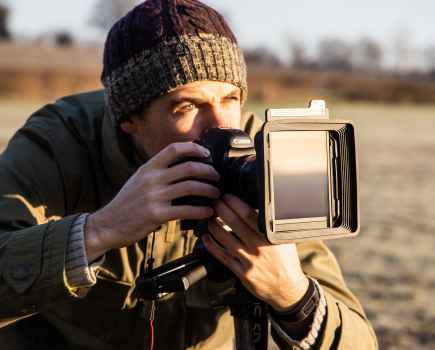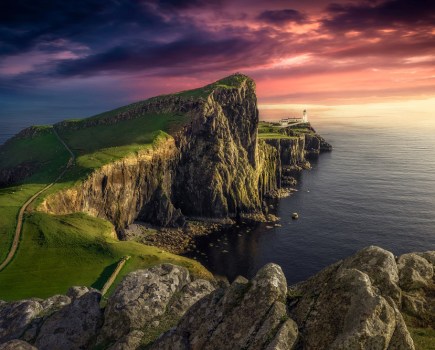Summer is often a landscape photographer’s least favourite season. This is because the sun is very high in the sky for most of the day, and often hazy either side of midday. There is an over-abundance of green foliage dominating the landscape, providing little in the way of contrast in colour for great summer landscape photographs.
The high sun also means harsh shadows, which are very unflattering on any subject; and if you want to capture a sunrise or sunset, then be prepared to rise very early or stay out late. But great summer landscape photographs are possible. To make the most of the summer months you need to adjust your approach and technique to suit the conditions.
Summer landscape photographs: Time of day
It may be better not to think about sunsets and be up early as you can to make the most of the early morning light instead.
The light at this time of the year is only at its best until around 10am before the sun gets too high in the sky.
Starting early at around 6am, not only means you can make the most of the warm, early light, but if shooting urban landscapes especially, then you often have the place to yourself.
Mid-morning is a good time to get the polarising filter out. The sun should just be at the right height in the sky to give maximum effect and as the atmosphere warms up, so the fluffy, white cumulus clouds start appearing in the sky. These are ideal to contrast with a rich, blue polarised sky. Remember that the sun still needs to be at a 90° angle to your subject, so it’s no use trying to get the filter to work with the sun behind you.
Once the day starts drawing in, you can concentrate on shooting beautifully lit summer landscape photographs again.
The best light often doesn’t appear until after 6pm, but by then the light will be much better, with softer shadows and warm light raking across the landscape.
You can also begin to plan your sunset shot, which may not be until late evening, but the colours in the sky are often spectacular at this time of the year
Summer landscape photographs: Locations
Although summer means an abundance of green fields, it’s also the time in the UK when crop fields are at their peak.
Wheat and barley fields are looking their best, swaying in the breeze as a sea of golden colour. Oil seed rape fields add a great splash of yellow to your views and are perfect against a rich blue sky. Red poppies appear around August and create another warm colour to add to your compositions.
Sunflowers and lavender fields are another classic summer flower and you don’t have to go to Provence to capture these either.
There are a number of lavender farms around the country and sunflowers can grow in the most unlikely locations, so be on the lookout for these on your travels.
Rivers and lakes are ideal subjects to incorporate as these look great at any time of the year. On a still day, look for them reflecting the surrounding countryside and hillsides and again use your polariser to enrich their colour and remove unwanted glare off their surface.
Summer landscape photographs: Alternatives
Although not strictly a landscape shot, this sunflower image does illustrate an alternative shot you can get as you work through the day.
The picture still shouts summer to you and the unique viewpoint makes a dynamic and creative image. The low-angle framing was achieved by holding the camera close to the ground and guessing the viewpoint.
After a couple of practice shots, I was able to get exactly the composition that I wanted, simply by checking the results on the rear LCD screen.
The blue sky adds the ideal plain, uncluttered backdrop to the flowers, while the partially hidden sun adds a sparkle to the image.
I switched to manual focus and worked out the distance by focusing on the ground from the height of the top of the flowers, thus giving me correct focus in reverse. Exposure was done manually, by overexposing from the metered reading until I got a nice even shape on the histogram.
Summer landscape photographs: Before You Go
- Have a number of locations noted that you want to visit. Keep a notebook with you at all times so that you can jot down the location of fields that look like there are crops growing to return to, especially rape seed and poppy fields.
- Be sure to pack a polarising filter to make the most out of a blue sky.
- A compass and sunrise/sunset table will ensure you are prepared for the last shot of the day.
- Take plenty of water if you are out all day in the summer as the exertion and warm weather will dehydrate you quicker.
- Sun cream and a hat are essential if shooting summer landscape photographs throughout the day.
Summer landscape photographs: Black & White
A dark and moody landscape can often benefit from being turned into black & white, as often they contain only muted colours in the first place and the texture and tone in a mono image can be pushed further to allow the image to really come alive.
There is a multitude of ways to convert your images to black & white, ranging from a simple removal of colour to a fully controllable multi-filtered approach. From Photoshop Elements you can use the remove colour tool or Desaturate in Photoshop (by pressing Shift+Ctrl+U on the keyboard).
Once converted, most images will also require a Levels adjustment and some careful use of the Dodge and Burn tools to really get the most out of them. If working from a Raw file, keep the image as a 16-bit file throughout, as it will allow more detail.

The Hue/Saturation palette, accessed via Ctrl+U, uses a slider to reduce saturation, which is useful should you wish to leave a hint of colour.











